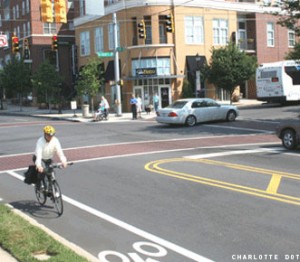 What are Complete Streets?
What are Complete Streets?
A “Complete Streets” approach focuses on moving people around a city, rather than moving cars. It involves designing and operating our roads to provide safe and convenient access for all users – whether they happen to be walking, riding the bus, driving, cycling or delivering goods on a given trip. It recognizes the need to plan for the most vulnerable road users – children/youth, seniors, persons with disabilities – which results in a design that fits all users.
Why would we want complete streets?
There are a number of benefits that can be gained by focusing on moving people rather than cars using a “Complete Streets” approach. Examples can include:
- Improves safety for everyone on the roadway
- Encourages more walking and cycling which benefits aging Manitobans; accommodates/encourages persons with disabilities to get out more; and helps children be physically active and gain independence
- Creates more efficient streets and reduces congestion
- Makes economic sense – a balanced transportation system creates accessible and efficient connections between residences, schools, parks, public transportation, offices, and retail destinations
- Saves money by doing it right from the start – integrating such items as sidewalks, bike lanes, transit amenities, and safe crossings into the initial design avoids expensive retrofits later
- Reduces transportation-related GHG emissions and improves air quality
where are there examples?
There are over 520 examples in the U.S., with the number of cities and states adopting policies growing monthly. A full list for the U.S. is available here on the National Complete Streets Coalition website.
In Canada, Calgary was the first to adopt a Complete Streets policy in 2009 followed by Waterloo in 2011. Check out Calgary’s Interim Complete Streets Design Guide (2011).
Find other examples on the Complete Streets Canada map, developed by the Toronto Centre for Active Transportation (TCAT), along with policy and design resources housed on the Complete Streets for Canada design and policy hub website. TCAT has also prepared case studies on Calgary’s experience to date as well as the communities of Waterloo and Thunder Bay.
Complete Streets Policies
For specific examples, here’s what the City of Chicago (another windy, wintery city) adopted in 2006:
The safety and convenience of all users of the transportation system, including pedestrians, bicyclists, transit users, freight and motor vehicle drivers shall be accommodated and balanced in all transportation and development projects and through all phases of a project, so that even the most vulnerable—children, elderly and persons with disabilities—can travel safely within the public right of way.
The City of Calgary worded their policy (Municipal Development Plan, section 2.5.3, and Transportation Master Plan, section 3.7) this way:
Objective: Increase the attractiveness, convenience and safety of all modes of transportation by creating a new selection of multi-modal streets that emphasize different modes of transportation, incorporate elements of green infrastructure and function in the context of surrounding land uses.
South of the border, our Minnesota neighbours to the south adopted a state law on Complete Streets, which applies to state-owned and -funded roads.
“Complete streets” is the planning, scoping, design, implementation, operation, and maintenance of roads in order to reasonably address the safety and accessibility needs of users of all ages and abilities. Complete streets considers the needs of motorists, pedestrians, transit users and vehicles, bicyclists, and commercial and emergency vehicles moving along and across roads, intersections, and crossings in a manner that is sensitive to the local context and recognizes that the needs vary in urban, suburban, and rural settings.
The City of Winnipeg committed in its Transportation Master Plan in 2011 to develop a Complete Streets strategy (p.37, section 5.1.3) and noted that:
A key underlying goal of the transportation plan is to expand the range of travel options that are available to residents, workers and visitors, and to ensure that people are not dependent on one single mode. Expanded travel choice creates countless community benefits. Providing greater access and options for walking, cycling and transit will lead to improved health, increased personal mobility, more livable and socially active communities, and reduced impacts on the environment and our climate.
Where to learn more
- Toronto Centre for Active Transportation (TCAT) – Complete Streets for Canada Policy and Design Hub
- National Complete Streets Coalition (U.S.)
- Complete Streets in Minnesota



Recent Comments